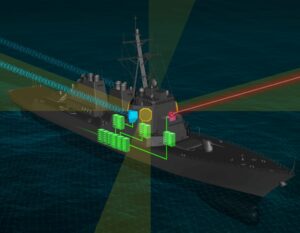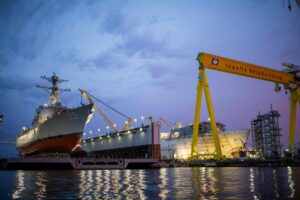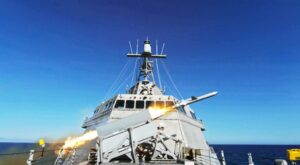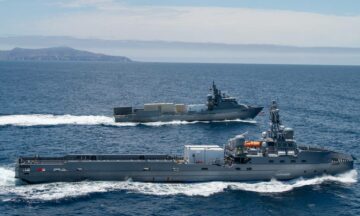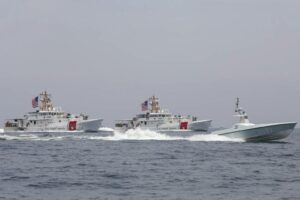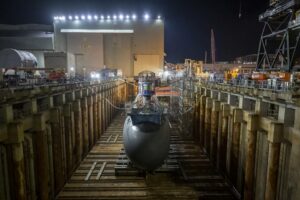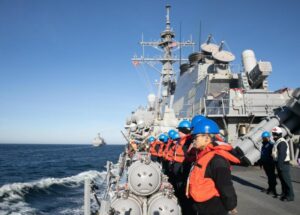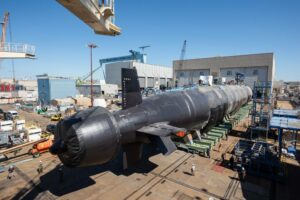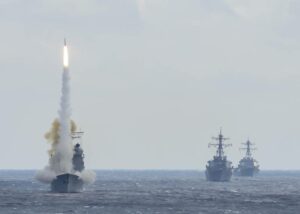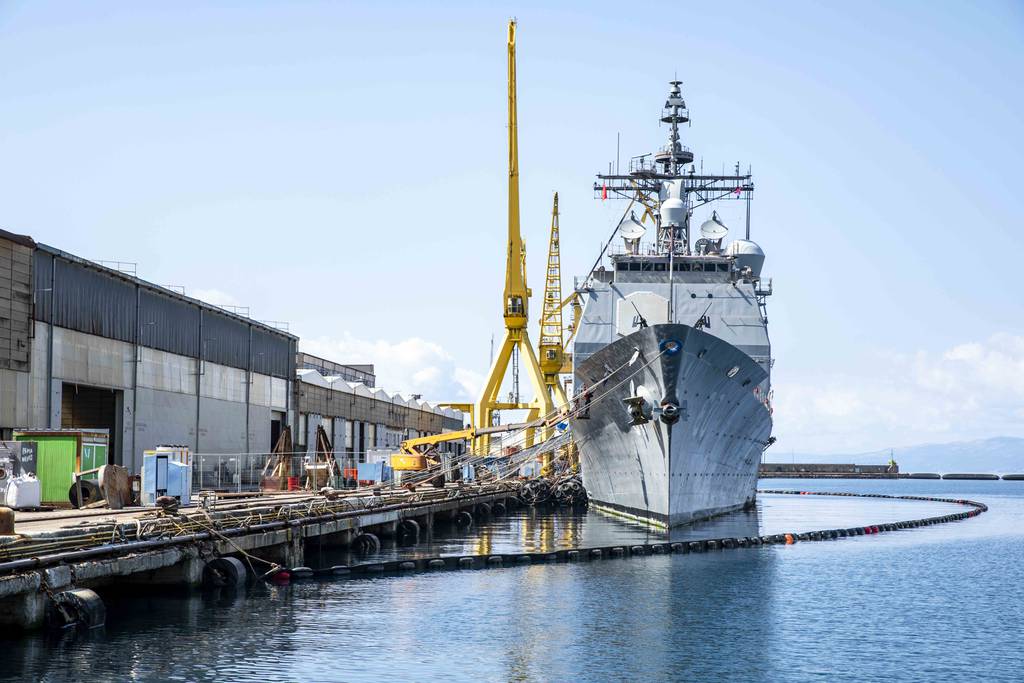
WASHINGTON — The U.S. Navy is working on a new wartime response plan that would affect how ships and crews prepare and deploy for combat, according to the head of U.S. Fleet Forces Command.
This comes as the Navy experiences firsthand in the Middle East what it requires to sustain a fighting force at sea.
The Navy has pushed additional destroyers into the Red Sea and Eastern Mediterranean regions as well as extended ships’ deployments to keep a heightened presence there. The moves come as Houthi militants in Yemen continue to fire missiles and send drones at naval and merchant ships, military forces ashore, and Israeli targets.
Adm. Daryl Caudle, who would be responsible for the East Coast fleet’s contribution to a conflict, said the Navy generally prepares its ships, planes and submarines for routine deployments through its Optimized Fleet Response Plan — a cycle of training, deployment and maintenance.
But “what can we do if I need to transition to warfighting footing more quickly? What is it I can deliver the forward commanders?” he said at this month’s Surface Navy Association conference.
He and his Fleet Forces staff are studying these questions and more to create a so-called Global Maritime Response Plan. This wouldn’t replace the regular drumbeat of forces generated by the Optimized Fleet Response Plan, but would supplement it if the naval force had to fight. The admiral said he hopes to have the plan drafted by the end of this year.
In the event of a major conflict, Caudle explained, the Navy would consider what maintenance requirements it could skip to deploy ships, what training can move quicker, what nontraditional ports could perform repairs, and what personnel could be reassigned to combat-focused positions.
For example, force-generation commands could send some staff to operational commands to stand on the watch floor, plan missions and more. The reserve component could cease nonessential tasks and move personnel to jobs supporting the conflict, Caudle said.
But much of the effort is focused on ships: How can the Navy increase the number of vessels and crew members that would be ready to deploy at a moment’s notice, and how can the service quickly repair ships damaged in battle in order to get them back into the fight?
Ship readiness
For every submarine not already deployed or in depot maintenance, Caudle said there’s a system that records the certifications of each crew, the boat’s material readiness, the ordnance onboard and more. This dashboard allows operational commanders to understand availability and barriers, and to reroute spare parts or reprioritize maintenance work if needed.
The surface navy is in the early stages of developing a similar plan for its combatants and amphibious ships.
Rear Adm. Dianna Wolfson, the fleet maintenance officer at Fleet Forces Command, said at the conference that she tested out these systems in last summer’s Large Scale Exercise. She attended the massive live, virtual and constructive drill to provide a dose of realism for fleet commanders: They had to consider the status of every ship under their command and make risk-based decisions about how to employ them based on their readiness.
She said an ongoing fleet maintenance optimization effort would give commanders better data for making decisions. This initiative would create a central repository for ship readiness data — updated constantly as sailors and shipyards work on the ships — and a digital twin of each vessel.
If regional tensions escalate, she said, the system would show which ships are prepared to deploy in real time, and which could be made ready if certain actions were taken.
Keeping up in combat
The other side of the equation involves keeping ships in the fight once they’ve arrived, as well as getting them back quickly if there’s a need for maintenance or repairs.
The fight in the Middle East today hasn’t led to any battle damage; the Houthis have shot missiles at naval ships, but the weapons have all missed, or defensive missiles have interception the threats. Still, the conflict has dragged on long enough that destroyers have had to rotate in and out to allow for crew members to rest and ships to undergo maintenance.
Rear Adm. William Greene, who is in charge of surface ship maintenance, said the Navy surged technicians and parts to its Forward Deployed Regional Maintenance Center — which covers work in Naples, Italy; Rota, Spain; and Manama, Bahrain — after Hamas militants attacked Israel on Oct. 7. The service expected it would see increased operations in the area and began pre-positioning resources to tend to those ships.
Greene said the service did the same thing after Russia launched its full-scale invasion of Ukraine in February 2022.
This helps ensure ships in the Middle East don’t have to go far for routine maintenance or to reload their weapons stocks.
But Greene said the Navy also has an eye on preparing for battle damage. The service in recent years incorporated battle damage into major exercises, putting decommissioned ships out to sea and detonating explosives onboard so sailors can practice towing ships back to port and running battle damage assessment and repairs.
Still, the Navy needs to involve industry in these drills, Greene said. In an overseas war, the Navy would tow ships into a foreign port. And while those yards may be capable of repairing the hull and its electrical and mechanical systems, they may not have expertise in the combat systems.
Greene said the service is considering how defense contractors could contribute to repairs affecting the warfighting systems they built.
Vice Adm. James Downey, the head of Naval Sea Systems Command, said the service is drafting a proposal for a future budget year to practice these scenarios at real shipyards in allied countries. This initiative would allow for up to six U.S.-based ships to undergo maintenance overseas — perhaps three in the Pacific and three in Europe — during repair periods of up to 90 days.
While 90 days is much shorter than a typical yard period at home, it would allow foreign repair facilities to learn how to do business with the Navy, understand American ship designs and systems, and lay the groundwork for potential emergency repairs.
Navy Secretary Carlos Del Toro has previously discussed conducting a Military Sealift Command ship repair period in India, with hopes of continuing the effort with repairs in Singapore and the Philippines.
Megan Eckstein is the naval warfare reporter at Defense News. She has covered military news since 2009, with a focus on U.S. Navy and Marine Corps operations, acquisition programs and budgets. She has reported from four geographic fleets and is happiest when she’s filing stories from a ship. Megan is a University of Maryland alumna.
- SEO Powered Content & PR Distribution. Get Amplified Today.
- PlatoData.Network Vertical Generative Ai. Empower Yourself. Access Here.
- PlatoAiStream. Web3 Intelligence. Knowledge Amplified. Access Here.
- PlatoESG. Carbon, CleanTech, Energy, Environment, Solar, Waste Management. Access Here.
- PlatoHealth. Biotech and Clinical Trials Intelligence. Access Here.
- Source: https://www.defensenews.com/naval/2024/01/30/us-navy-works-on-war-response-plan-amid-red-sea-ship-surge/
- :has
- :is
- :not
- $UP
- 11
- 2022
- 2023
- 2nd
- 30
- 7
- 70
- 90
- a
- About
- According
- acquisition
- actions
- Additional
- affect
- affecting
- After
- All
- allow
- allows
- already
- also
- American
- Amid
- an
- and
- any
- ARE
- AREA
- arrived
- AS
- assessment
- Association
- At
- availability
- back
- bahrain
- barriers
- based
- Battle
- Bay
- BE
- began
- Better
- budget
- Budgets
- built
- business
- but
- by
- CAN
- capable
- carlos
- Center
- central
- certain
- certifications
- charge
- class
- Coast
- combat
- come
- comes
- component
- conducting
- Conference
- conflict
- Consider
- considering
- constantly
- constructive
- continue
- continuing
- contractors
- contribute
- contribution
- corps
- could
- countries
- covered
- covers
- create
- crew
- cycle
- damage
- dashboard
- data
- Days
- decisions
- Defense
- defensive
- del
- deliver
- deploy
- deployed
- deployment
- deployments
- designs
- developing
- DID
- digital
- digital twin
- discussed
- do
- Dont
- dose
- drafted
- Drones
- during
- each
- Early
- East
- east coast
- eastern
- effort
- emergency
- end
- enough
- ensure
- escalate
- Europe
- Event
- Every
- example
- expected
- Experiences
- expertise
- explained
- extended
- eye
- facilities
- far
- February
- fight
- fighting
- Filing
- Fire
- firsthand
- FLEET
- Floor
- Focus
- focused
- For
- Force
- Forces
- foreign
- Forward
- four
- from
- full-scale
- future
- generally
- generated
- geographic
- get
- getting
- Give
- Global
- Go
- groundwork
- had
- hamas
- Have
- he
- head
- heightened
- helps
- his
- Home
- hopes
- How
- How To
- HTTPS
- i
- if
- images
- in
- Incorporated
- Increase
- increased
- india
- industry
- Initiative
- into
- invasion
- involve
- involves
- Israel
- Israeli
- IT
- Italy
- ITS
- james
- Jobs
- jpg
- june
- Keep
- keeping
- large
- launched
- lay
- LEARN
- Led
- left
- live
- Long
- made
- maintenance
- major
- make
- Making
- Marine
- Maritime
- Maryland
- massive
- material
- May..
- mechanical
- Mediterranean
- Megan
- Members
- Merchant
- Middle
- Middle East
- Military
- missed
- missiles
- missions
- more
- move
- moves
- much
- Need
- needed
- needs
- New
- news
- nontraditional
- Notice..
- number
- Oct
- of
- Officer
- on
- Onboard
- once
- ongoing
- operational
- Operations
- optimization
- optimized
- or
- order
- Other
- out
- overseas
- Pacific
- parts
- Paul
- perform
- perhaps
- period
- periods
- Personnel
- Philippines
- plan
- Planes
- planned
- plato
- Plato Data Intelligence
- PlatoData
- ports
- positions
- potential
- practice
- Prepare
- prepared
- Prepares
- preparing
- presence
- previously
- Programs
- proposal
- provide
- pushed
- Putting
- Questions
- quicker
- quickly
- Readiness
- ready
- real
- real-time
- recent
- records
- Red
- regional
- regions
- regular
- repair
- repairing
- replace
- Reported
- reporter
- repository
- Requirements
- requires
- Reserve
- Resources
- response
- responsible
- REST
- review
- routine
- running
- Russia
- s
- Said
- same
- Scale
- scenarios
- SEA
- secretary
- see
- send
- service
- she
- ship
- ships
- shot
- show
- side
- similar
- since
- Singapore
- SIX
- So
- some
- Spain
- Staff
- stages
- stand
- Status
- Still
- Stocks
- Stories
- Studying
- supplement
- Supporting
- Surface
- surge
- Surged
- system
- Systems
- taken
- targets
- tasks
- tend
- tensions
- tested
- than
- that
- The
- The Area
- The Philippines
- their
- Them
- There.
- These
- they
- thing
- this
- this year
- those
- threats
- three
- Through
- time
- to
- today
- Training
- transition
- twin
- typical
- u.s.
- U.S. Navy
- Ukraine
- under
- undergo
- understand
- university
- University of Maryland
- updated
- us
- Vessel
- vessels
- Virtual
- Voyage
- war
- Watch
- we
- Weapons
- WELL
- were
- What
- What is
- when
- which
- while
- WHO
- william
- with
- Work
- working
- works
- would
- would give
- year
- years
- zephyrnet

